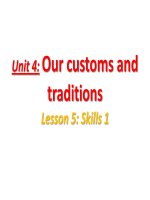Unit 04 Our Customs and Traditions Lesson 1 Getting started
Bạn đang xem bản rút gọn của tài liệu. Xem và tải ngay bản đầy đủ của tài liệu tại đây (1.13 MB, 15 trang )
<span class='text_page_counter'>(1)</span>Unit 4: Our customs and traditions. Lesson 1: Getting started. Teacher : Nguyen Thi Thuy.
<span class='text_page_counter'>(2)</span> Welcome to our class.
<span class='text_page_counter'>(3)</span> 1.Matching. A. B. 1. accept. 1 + D A. Totally correct. 2. Spot on. 2 + A B. grandparents, parents,. 3. sharp. 3 + F C. A polite way of eating at. 4. social. 4 + E D. agree. 5. Table manner. 5 + C E. Relating to human. 6. generations. 6 + B F. Exactly on time. children......... the dinner table. society.
<span class='text_page_counter'>(4)</span>
<span class='text_page_counter'>(5)</span> Teacher: Today we’re going to learn about customs and traditions. Do you think they’re the same? Mi:. I think they’re different, but it’s hard to explain how.. Nick: In my opinion, a custom is something that has become an accepted way of doing things. And a tradition is something we do that is special and is passed down through the generations. Teacher: Yes, spot on! Give me an example of a custom. Mai:. My family has this custom of eating dinner at 7 p.m. sharp.. Teacher: Really? Mai: Yes, we have to be at the dinner table on time. Teacher: That’s interesting! How about a tradition, Phong?.
<span class='text_page_counter'>(6)</span> Phong: We have a family tradition of visiting the pagoda on the first day of every lunar month. Nick:. You’re kidding!. Phong:. No, no. We’ve followed this tradition for generations.. Teacher: You’ve mentioned family, but what about social customs and traditions, Nick? Nick: Well, in the UK there are lots of customs for table manners. For example, we have to use a knife and fork at dinner. Then, there’s a British tradition of having afternoon tea at 4 p.m. Teacher: Sounds lovely! Now, for homework, you should find information about a custom or tradition. You’re doing mini presentations next week....
<span class='text_page_counter'>(7)</span> Teacher: Today we’re going to learn about customs and traditions. Do you think they’re the same? Mi: I think they’re different, but it’s hard to explain how. Nick: In my opinion, a custom is something that has become an accepted accepted way of doing things. And a tradition is something we do that is special and is passed down through thegenerations. generations. Teacher: Yes, spot on on! Give me an example of a custom. sharp Mai: My family has this custom of eating dinner at 7 p.m. sharp. Teacher: Really? Mai: Yes, we have to be at the dinner table on time. Teacher: That’s interesting! How about a tradition, Phong? Phong: We have a family tradition of visiting the pagoda on the first day of every lunar month. Nick: You’’re re kidding! kidding! You Phong: No, no. We’ve followed this tradition for generations. Teacher: You’ve mentioned family, but what about social customs and traditions, Nick? Nick: Well, in the UK there are lots of customs for table manners. manners For example, we have to use a knife and fork at dinner. Then, there ’s a British tradition of having afternoon tea at 4 p.m. Teacher: Sounds lovely! Now, for homework, you should find information about a custom or tradition. You’re doing mini presentations next week....
<span class='text_page_counter'>(8)</span>
<span class='text_page_counter'>(9)</span> 1b (p.39): True (T) or false (F).. T F 1. Nick’s explanation of customs and traditions is correct.. T. 2. Only families have customs and traditions. 3. In the UK there’s a tradition of having afternoon tea. 4. In the UK there is no accepted way of behaving at the dinner table.. F T F.
<span class='text_page_counter'>(10)</span> 1C (p.39): Answer the questions. 1. What is Mai’s family custom? It’s eating dinner at 7 p.m. sharp. 2. How does Nick feel when Phong talks about one of his family traditions? He’s surprised. 3. Is a custom the same as a tradition? No , it is not. 4. What is the difference between them? A custom is something accepted. A tradition is something special and is passed down through the generations. 5. What should the students do for homework? They should find information about a custom or tradition..
<span class='text_page_counter'>(11)</span> 1d (p.39). Find these sentences in the conversation and fill in the missing words. 1. We _________ have to be at the dinner table on time. should 2. You _________find information about a custom or tradition.. Have to: It’s an obligation. Should: It’s a suggestion or advice..
<span class='text_page_counter'>(12)</span> 2a(p.39). Match the pictures with the customs and traditions. 1.. a.. b.. g.. 2. c.. worshipping ancestors. 3. f.. wrapping gifts in colourful paper. 4. h.. having lunch together on the second day of Tet. 5.. placing the chopsticks on top of the rice bowl when finishing a meal. e.. 6.. c.. d.. smiling to accept a compliment. children in the family standing in a row to greet a. guests. 7.. wearing ao dai on special b. occasions. 8.. giving children lucky money d. at Tet. e.. f.. g.. h..
<span class='text_page_counter'>(13)</span> 2b(p.39). Write C (custom) or T (tradition) next to each activity. In pairs, compare your answers. 1. smiling to accept a compliment 2. worshipping ancestors 3. wrapping gifts in colourful paper 4. having lunch together on the second day of Tet. C C or T C T. 5. placing the chopsticks on top of the rice bowl when finishing a meal. C. 6. children in the family standing in a row to greet guests. C. 7. wearing ao dai on special occasions 8. giving children lucky money at Tet. T C or T.
<span class='text_page_counter'>(14)</span> HOMEWORK 1.Learn voc by heart. 2. Redo all the exercises p.39. 3. List some customs and traditions in your village. 4. Listen and read the dialogue again..
<span class='text_page_counter'>(15)</span>
<span class='text_page_counter'>(16)</span>









